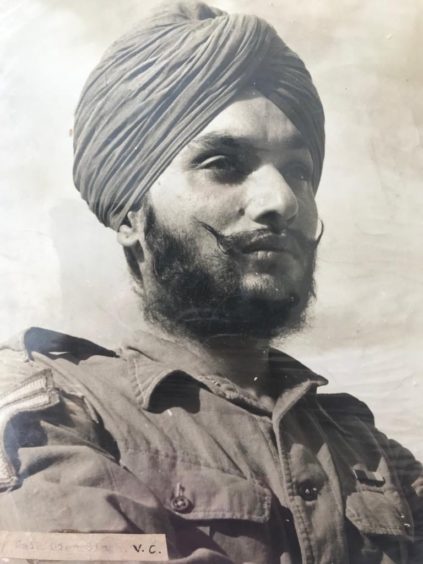They are old men now and their eyes are full of sleep.
But the contribution of so many soldiers from across the Commonwealth was an important factor throughout the Second World War.
As the 75th anniversary of VJ Day approaches, the sacrifices made by service personnel from every corner of the Commonwealth is being highlighted.
The Fourteenth Army was described as the largest all-volunteer army in history with 2,500,000 men and was instrumental in securing victory in the Far East.
Although large numbers of Britons served in the Fourteenth, an estimated 80% of the fighting force came from units from India, East and West Africa and other parts of the British Empire.
They include VJ Day veteran, Darbara Singh Bhullar, who was born in India and now lives in Glasgow, and has recalled his time in the Far East.
The campaign to retake Burma was one of the longest fought by the British during the war and, while the fighting was fierce, the threat posed by disease was equally deadly.
Mr Bhullar, 97, said: “I entered the Army on February 17 1942. We fought against Japan on the Burma front until 1945. When we were fighting against Japan, we faced many difficulties…so many difficulties that I cannot even describe.
“Our first enemy was Japan. Our second enemy were mosquitoes. If you were bitten by a mosquito, it would infect all of your blood.
“Few were killed by bullets and more by mosquitoes.
“We had to endure so many difficulties. It was always very hot, so we would not wear much and that would mean mosquitoes would bite.
“Then we went to Assam. It was the rainy season there, and leeches would attach to us despite us wearing socks and boots. There was no place to stay; only the jungle.
“We were amongst the animals and some of us died along with the animals.
“My job was communication; telephonic or wireless communication, or using a car or Jeep or motorcycle. We had to keep the communication up, one way or another. If communication was to stop, that would be the end for the troops.”
Another for whom VJ Day will be particularly poignant is Charanjit Sangha, 56, whose father, Naik Gian Singh, was awarded the Victoria Cross for his bravery in battle.
Mr Sangha, from Newton Mearns, said: “My Dad joined the British Army in 1937. He was only 17 and served in the 15th Punjab Regiment.
“My father told me that, and I heard from other people, that wherever there were difficult times, or they knew that the enemy was stronger, the last resort used was to put the Punjab Regiment in there; they will sort it out.
“My Dad used to tell us that all of the people around him were killed. He was the last one there. He was only about 50 yards from the enemy foxhole.
“He could see 15-20 Japanese troops there and an anti-tank gun. He knew that, if he tried to run back, he wouldn’t survive because there was no back-up at all.
“He thought: ‘I am going to die now, so I might as well do something.’
“He grabbed hold of his machine gun and some hand grenades and got up in front of the enemy and he started throwing the hand grenades. The Japanese were not expecting that as they thought the enemy was all dead.
“He killed all of them and captured the anti-tank gun. By doing that, the route was clear for the Army to come back.
“He was badly injured after that and unconscious for a few days. The bullets were all over him. Until his dying day, in 1996, his leg always used to hurt from those wounds.
“Years later, my father chose to receive the Victoria Cross in London. There was a big, big parade in London’s Hyde Park.”
Mr Sangha added: “I feel sad that my father is not here with us, but I am excited that today we are talking about the contribution which was made by Commonwealth countries during the Second World War.
“I do not think we had that before and this is why VJ Day will be so poignant. These men were great soldiers and it’s important this story is told in our schools and communities.”
The VJ Day commemorations will be marked by a series of “virtual” events, organised by Legion Scotland and Poppyscotland, in partnership with the Scottish Government.
A series of programmes will be broadcast live via the charities’ social media channels to mark the milestone anniversary. A virtual Service of Remembrance will be shown from 10.35am on Saturday August 15 and will be followed at midday by a virtual concert.
On Monday August 17, which will mark the first full week of the new school term, a live lesson will help to ensure that younger generations have an opportunity to learn more about the significance of VJ Day.
Legion Scotland’s chief executive Dr Claire Armstrong said: “The stories of Mr Bhullar and Mr Naik gives us a rare and poignant insight into what life was like in the Far East during the war.
“The Fourteenth Army are often referred to as the “Forgotten Army”, but it is vital that, as we approach the 75th anniversary of VJ Day, the bravery and sacrifice of these men is forgotten no more.”



